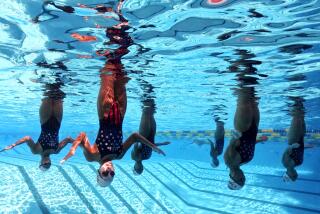Experts Fish for Clues to Better Swimming
- Share via
WASHINGTON — Swim like a fish? It’s not possible unless you are one, experts say.
But it is possible to study fish and learn to swim like a better human.
“These creatures have evolved for millennia,” said U.S. national team coach Jonty Skinner in Colorado Springs, Colo. “If they don’t know how to do it right . . . “
Skinner tries to apply some fish skills when he trains his swimmers for the 2000 Olympics in Sydney, Australia. For instance, he likes to see “total body action” as a swimmer moves through the water. A whole-body movement, with a mild undulation, is more fishlike and more efficient, he said.
“A normal human being would say the fish is flapping its tail and creating propulsion,” Skinner said. “Actually, it’s not. It’s the total movement of the body.”
A shark’s swimming motion, for instance, starts with the head, grows through its powerful body and gets final propulsion from the tail, Skinner said.
Not that the tail motion is unimportant, said zoology professor Frank E. Fish of West Chester University in West Chester, Pa. The down-and-up motion of a dolphin’s flukes creates a sort of pocket of low water pressure on one side of the tail and high pressure on the other, he said. The dolphin’s body is pulled toward the lower pressure and pushed away from the higher pressure, he said.
The dolphin kick works less well for people because their knees don’t bend in both directions as a dolphin’s flukes do, Fish said. Just the same, visualizing a dolphin may help people with their dolphin kicks, he said.
A sea lion’s flippers are long enough to create a pressure differential, giving the same lift effect that helps dolphins move forward, Fish said. Breast-strokers can hold their hands at a slight angle to the flow of water going past and get some of the lift effect themselves, he said.
However, hands don’t have a flipper’s water-friendly form, Fish said. A hand is comparatively stubby, and it primarily pushes against the water like a paddle. By pushing against the resistance of the water, the swimmer moves forward, he said.
More important, fish can teach people about streamlining, Fish said. A straighter body line has less drag against the flow of water. Swimmers can reduce drag by not having their elbows and knees stuck out at odd angles.
People also can spend more time underwater, said researcher M. Edwin DeMont of St. Francis Xavier University, Antigonish, Nova Scotia. This reduces the drag of waves on the surface, he said. Under the water, drag is minimized and a swimmer can go faster; a foot and a half underwater is all the depth that most swimmers need, he said.
On the other hand, swimming organizations realize this and have set rules that limit distance underwater.
Diligent study or no, “It’s unlikely that humans will swim like fish to the same level of efficiency,” said zoology professor Thomas Daniel of the University of Washington. Fish have some built-in advantages that go beyond even their fins and tails, he said.
For instance, fish slime apparently reduces the frictional drag of the fish’s body through the water, Daniel said. People don’t know how to duplicate this slippery stuff.
“There have been stories of swimmers covering themselves in Vaseline,” Daniel said. “It wouldn’t work.”
More to Read
Go beyond the scoreboard
Get the latest on L.A.'s teams in the daily Sports Report newsletter.
You may occasionally receive promotional content from the Los Angeles Times.







